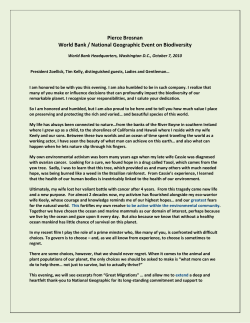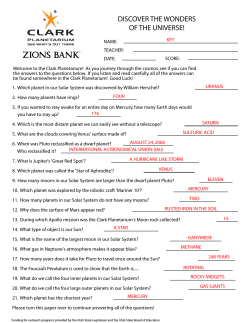
sustainable science for sustainability? A reflexive approach for the present time for the present time.
How to devise a sustainable science for sustainability? A reflexive approach for the present time for the present time. Elena Camino, IRIS (www.iris.unito.it) Centro Interuniversitario di Ricerche Interdisciplinari sulla Sostenibilità A few p preliminaryy q questions… In this Conference, where , there women p panelists duringg morningg sessions? Why no‐one mentions the involvement of science in military research, and the absence of research on the environmental i impact of war t f ? ? Why the great texture of evolution, which is continuously h h f l i h h l acting at all organizational levels of life, is missing from the discourses? If I ask you to 'look' towards the future, in If I ask you to look towards the future, in which direction you turn your gaze? Why we are here? • • • • • For enchantment of life… Out of affection for our loved ones … Because we are angry … For respect towards other peoples and cultures … … • • • • • • From one science to many sciences How to deal with complexity? The dependence on world views revealed by metaphors Lookingg upstream p to identifyy the frames Looking downstream to understand the approach to future The PN science and the need of a multiplicity of legitimate perspectives A Manifesto signed by more than 520 scientists: g y scientists’ consensus on maintaining humanity’s life support systems in the 21st century life support systems in the 21 Five global problems: Five global problems: 1. climate disruption, 2. extinctions, 3. loss of ecosystem y, p , p p g diversity, 4. pollution, 5. human population growth and resource consumption The most highly rated academic journals embrace and augment the view of a science that will continue to bring solutions and innovation to i f i th t ill ti t bi l ti di ti t overcome the current crisis: “Scientists and engineers […] share a belief that increased fundamental knowledge about the natural belief that increased fundamental knowledge about the natural world will lead to human progress…”. (Alberts 2008, p. 1435). Tartaglia, Mercalli & Ulgiati (2013), referring to the controversy about the high speed train in Valsusa, ask the President of Italy to assume the task of “promoting the public debate, qualified and independent, based on data, measurement and scientific method which will help everyone to put an end to social unrest method, which will help everyone to put an end to social unrest and violence” Science is an open‐ , , , minded, universalist, disinterested, and communal activity. Quantitative approach to ht natural systems SCIENCE for SCIENCE for sustainability? I Improve forecasting f ti Emulating nature Measures of processes, cycles, fluxes Models and projections New New renaissance period Improve earth system system governance Responsible stewardship Dramatic cultural change ??????? But what about the natural systems whose complexity transcends us, and whose evolutionary dynamics includes us as internal sub-systems? How to deal with the unforeseen, the unexpected? With uncertainty and ignorance? ??????? All scientific enterprises claim that they deal with facts, and they are based on the scientific method and on experimental evidence … but b allll depend d d on the h language! g g Metaphors are the mind mind’ss eyes and society society’ss tools. They provide us with visions of the world and d instruments i t t to t change h it (Nerlich, Jaspal 2012) Citizens, public administrations and policy‐ makers are encouraged to trust science in order to make sound private and public decisions. to make sound private and public decisions. But… which science should science should be trusted??? Obviously, interdisciplinary science, but… Traditional, descriptive SCIENCE? Innovative, transformative SCIENCE? Quantitative, interpretative, p SCIENCE? Models and metaphors and metaphors are the way to are the way to describe, give sense, and to communicate SCIENCE SCIENCE Zombie Endocrine Disruptors Metaphors translate worldviews and and mental frames into narratives The study of science is ALSO the study of the h d f h d f h metaphors used by scientists. Science is not d designed ONLY from the encounter between human d f h b h reason and the natural world: it emerges from the prevailing ideas about the relationship between l d b h l h b humanity and nature. GRAIN Genomics, Robotics, Artificial Intelligence , Nanotechnology Big, industrial, goal‐ oriented technoscience INNOVATION INNOVATION SCIENCE The nanoworld ANALOGIES… … if a nanoparticle were the size of a football, an actual football would be the size of New Zealand … are different from METAPHORS: “Think of them [nanorods] like soldiers attacking an enemy base. The gold nanorods are the Special Forces, who come in first to mark the target. Then the Air Force flies in to deliver the laser‐guided bomb. The devices are designed to minimize collateral damage to th restt off the the th body.” b d ” (M. Sailor, prof. of chemistry and biochemistry) Smart bombs that could smash could smash cancer nano‐weapon hope for cancer stealth tactics to hit to hit cancer cells hard Science is dependent on cultural imaginaries Virginia Gewin, Nature 460, 2009 In the future, nanotechnology could be used to fight pathogens. The Roots of Nanoscience Nautilus, in the book Mistery Island (1874) Issac Asimov's Fantastic Voyage (1966) Science is inspired by imagination Computer artwork of a medical nanorobot p holding a sperm cell. Microscopic robot g p p technology could be developed in the future to treat disorders, such as infertility, in new ways. VICTOR HABBICK VISIONS / SCIENCE PHOTO LIBRARY Where will synthetic biology take us? The biological parts, genetic circuits, and fabrication techniques that have been developed and continue to techniques that have been developed and continue to be improved offer exciting potential in diverse applications, from environmental engineering to applications, from environmental engineering to regenerative medicine. …synthetic biology is poised to transform our ability to …synthetic biology is poised to transform our ability to probe, understand, and manipulate biology. Chen et al. Genome al Genome Biology 2012, 13:240 http://genomebiology.com/2012/13/2/240 2012 13:240 http://genomebiology com/2012/13/2/240 Engineering & Synthetic Biology Living parts gp as p pieces of LEGO Cells as ‘micro‐chips’ The key enzyme in photosynthesis, Rubisco, is a relic of a bygone age. The ability to assemble Rubisco in the a bygone age. The ability to assemble Rubisco in the test tube offers the prospect of genetically manipulating the enzyme to make it fit for the modern manipulating the enzyme to make it fit for the modern world. (J. Ellis, 2010) The power of metaphors resides in their ability to serve as translational devices between different articulations of science translational devices between different articulations of science But describing genetic But describing genetic systems as though they are electrical ones (whereby genes are switched on and off) works to a degree. k t d Pawels, Nature, 2013 Language reveals frames and imaginaries and imaginaries … is applying sunblock to the planet… is repairing the planet. repairing the planet. The planet is a machine … is manipulating the planet’s thermostat The planet is a body … is applying medical treatment to the i l i di l t t t t th planet Th l t i The planet is a patient ti t Different imaginaries, different metaphors Towards a physiology of the Earth Is the biosphere hyperventilating? Shifting biomes, monsoons, currents … By 2100 some 40 percent of ´major ecological community types´ – that is biomes like forest, grassland, tundra – will have switched to a different state. Tropical cyclones are not passive players in Earth’ climate systems, p y p p y y , rather they actively contribute to the dynamics of ocean and atmosphere (Sriver, 2013) We are pushed by all scientific experts to rely on We are pushed by all scientific experts to rely on SCIENCE to tackle the global, challenging issues of our time issues of our time But… on which of the sciences that are present on the market, which run in a highly competitive race to get more and more private and public funds and promise to give practical answers to the planet’s turmoil? •Shall Shall we turn to the reassuring image of techno techno‐science, science, that offers short term, innovative and powerful answers to urgent problems? •Or shall we prefer to collect data ever more numerous, accurate and reliable of the ongoing global transformations in order d to govern the h planet l i a sustainable in i bl way ? Each scientific knowledge about natural systems expresses a world view and the related narratives UPSTREAM, research questions are formulated according to the y g underlying view: what kind of relation we conceive between humans and nature? Whi h Which are most meaningful variables to be investigated? t i f l i bl t b i ti t d? Who is entitled to participate in the research? DOWNSTREAM, different concepts of risk, uncertainty and ignorance provide different answers to the question “what if”: How will natural systems react? How shall we cope with unforeseen outcomes? Who will benefit and who will suffer damage? Post normal science Post normal (S. Funtowiz, J.Ravetz 1999) The modern programme h d of scientists teaching truth to f h h power, deducing correct policies from uncontrovertible f facts, is, in the environmental field, in tatters. h l f ld Post‐Normal Science (PNS) is a new conception of the management of complex science‐related issues. It focuses on aspects of problem solving that tend to be neglected in traditional accounts problem solving that tend to be neglected in traditional accounts of scientific practice: •uncertainty uncertainty • value loading •aa plurality of legitimate perspectives plurality of legitimate perspectives F From experiments i t to t experience i S. Funtowiz, J.Ravetz 1999 Decision stakes high Post normal science Professional consultancy Applied science L Low Low Systems y uncertaintyy High From isolated, bounded subsystems to global inter‐related socio‐ecosystemns to experience Excess of objectivity (Sarewitz 2004) For a given value‐based position in an environmental controversy it is often possible to compile a supporting controversy, it is often possible to compile a supporting set of scientifically legitimated facts. R di l uncertainty Radical t i t (J.P. Dupuy, 2004) Our uncertainty regarding the behavior of complex systems Our uncertainty regarding the behavior of complex systems has nothing to do with a temporary insufficiency of our g , y g j , knowledge, it has everything to do with objective, structural properties of complex systems. Post normal model The ideal of rigorous scientific demonstration is replaced by an Th id l f i i ifi d i i l db ideal of open public dialogue. Inside the knowledge production process citizens become both critics and creators process, citizens become both critics and creators. . Their contribution has not to be defined as ‘local’, ‘practical’, ‘ethical’ or ‘spiritual’ knowledge, but it has to be considered and accepted as a plurality of rightful and coordinated perspectives with their own meaning and value structures (Liberatore and F t i 2003). Funtowicz 2003) democratizing d i i science i expertizing citizens Letture Letture AA.VV. Late lessons from early warnings: science, precaution, innovation . EEA Report No 1/2013. Benessia, A., Funtowicz, S., Bradshaw, G., Ferri, F., Raez‐Luna, Benessia A F nto ic S Bradsha G Ferri F Rae L na E.F., and Medina. Hybridizing sustainability: toward a new praxis for the present human predicament. Sustainability praxis for the present human predicament. Sustainability Science 7(Supplement 1): 75‐89 (2012) . Funtowicz S. and Ravetz J. Science for the Post‐Normal Age”, Futures, 25:735‐755 (1993). Cini M. Il supermarket di Prometeo. Codice, Torino (2006).
© Copyright 2025





















